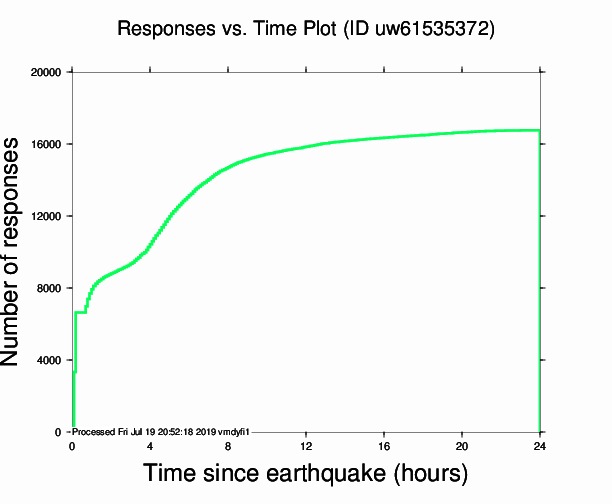Ml=4.6 Monroe Earthquake of July 12, 2019
The M4.6 earthquake that happened about a week ago was felt by many in the Seattle region. Within the first 24 hours, the USGS received more than 16,000 felt reports. See the figure below that we downloaded from the USGS Did You Feel It? page.

For more specific information about the Monroe Magnitude 4.6 earthquake of July 12, 2019 please see its specific event page where you will find a number of tabs that lead to more detailed information about this event. This includes the Maps tab, which will lead to links to ShakeMaps, the USGS's DYFI page, and a map of historic seismicity in the area. The Technical detail contains the first-motion focal mechanism, Waveforms show some sample waveforms or seismograms and, specially for this event, an Additional Information page that contains some text and graphics generated by seismologists.
A little airing of dirty laundry is appropriate here. Our public notification for this earthquake was not released until 41 minutes after it occurred. Our goal is to have information available within 5 to 10 minutes following a "likely-to-be" felt event (Mag >= 3). There are a number of reasons (excuses) for this delay not the least being that I (this blogger, Steve) was not awakened by either its shaking nor the pager alert from the automatic systems because I had not put the pager/phone next to my bed. The other duty seismologist did respond but was swamped with the many things needing to do right off. Another issue was the fact that the automatic system, while getting a good location and magnitude flagged it as "DUBIOUS" because of high uncertainty in the automatically determined magnitude. Thus the unreviewed solution was not released automatically. It took some time for the swamped seismologists working on the event (from home) to do the necessary analysis to release the information. We are working on improving both the automatic system and methods of rapidly reviewing events, even when groggy from the late night wakeup.
This event was felt well enough to get lots of interest from the public and press. News media started calling our phone lines and our outreach people very soon and by the normal work day requests for information and interviews were piling up at a great rate. Keeping up with the requests was impossible so it was hit and miss for which media outlet could talk to a human seismologist. We did set up a scheduling plan to log calls and phone back those who wanted it but this didn't get rolling until late in the morning.
Besides trying to talk with media folks we were trying to look in more detail at the main earthquake and its aftershocks. While deep crustal earthquakes in western Washington typically don't have as vigorous aftershock sequence as shallow events there were still a dozen or so locatable events within the first 12 hours. The US Geological Survey has a program to help give estimates of the likely number of aftershocks that would follow a large event within the first day or week. Their early estimate was that there was a 50% chance of a magnitude 3 or greater earthquake within the first week. The largest aftershock thus far was a Ml=3.5 earthquake 2 minutes and 20s after the main shock. Six days later, a M=2.97 (ie a magnitude 3 earthquake) ocurred and thus their forecast seems reasonable. The forecast for the same sized earthquake for the next week is down to a few percent change. Thus, while unlikely, another felt event is still possible.
As more information about this event is generated or analysis done it will be added to the "additional info" page for this event.